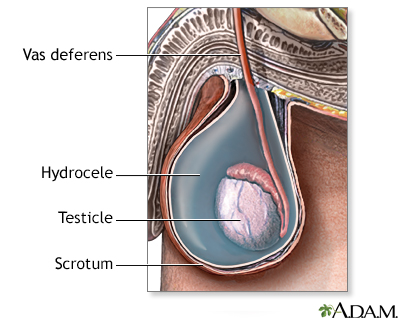
Hydrocelectomy
Hydrocele repair is surgery to correct the swelling of the scrotum that occurs when you have a hydrocele. A hydrocele is a collection of fluid around a testicle.
Baby boys sometimes have a hydrocele at birth. Hydroceles also occur in older boys and men. Sometimes they form when there is also a hernia (an abnormal bulging of tissue) present. Hydroceles are fairly common.


Surgery to repair a hydrocele is often done at an outpatient clinic. General anesthesia is used so you will be asleep and pain-free during the procedure.
In a baby or child:
In adults:
Needle drainage of the fluid is not done very often because the problem will always come back.
Hydroceles often go away on their own in children, but not in adults. Most hydroceles in infants will go away by the time they are 2 years old.
Your surgeon may recommend hydrocele repair if the hydrocele:
The repair may also be done if there is a hernia associated with the problem.
Risks of any anesthesia are:
Risks of any surgery are:
Tell your surgeon or nurse if:
Planning for your surgery:
During the week before your surgery:
Recovery is quick in most cases. Most people can go home a few hours after surgery. Children should limit activity and get extra rest in the first few days after surgery. In most cases, normal activity can start again in about 4 to 7 days.
The success rate for hydrocele repair is very high. The long-term outlook is excellent. However, another hydrocele may form over time, especially if a hernia was present.
Di Carlo HN, Crigger CB. Disorders and anomalies of the scrotal contents. In: Kliegman RM, St. Geme JW, Blum NJ, et al, eds. Nelson Textbook of Pediatrics. 22nd ed. Philadelphia, PA: Elsevier; 2025:chap 582.
Hawksworth DJ, Khera M, Herati AS. Surgery of the scrotum and seminal vesicles. In: Partin AW, Dmochowski RR, Kavoussi LR, Peters CA, eds. Campbell-Walsh-Wein Urology. 12th ed. Philadelphia, PA: Elsevier; 2021:chap 83.
Palmer LS, Palmer JS. Management of abnormalities of the external genitalia in boys. In: Partin AW, Dmochowski RR, Kavoussi LR, Peters CA, eds. Campbell-Walsh-Wein Urology. 12th ed. Philadelphia, PA: Elsevier; 2021:chap 44.
BACK TO TOPReview Date: 1/1/2025
Reviewed By: Kelly L. Stratton, MD, FACS, Associate Professor, Department of Urology, University of Oklahoma Health Sciences Center, Oklahoma City, OK. Also reviewed by David C. Dugdale, MD, Medical Director, Brenda Conaway, Editorial Director, and the A.D.A.M. Editorial team.

|
A.D.A.M., Inc. is accredited by URAC, also known as the American Accreditation HealthCare Commission (www.urac.org). URAC's accreditation program is an independent audit to verify that A.D.A.M. follows rigorous standards of quality and accountability. A.D.A.M. is among the first to achieve this important distinction for online health information and services. Learn more about A.D.A.M.'s editorial policy, editorial process and privacy policy. A.D.A.M. is also a founding member of Hi-Ethics and subscribes to the principles of the Health on the Net Foundation (www.hon.ch). |
The information provided herein should not be used during any medical emergency or for the diagnosis or treatment of any medical condition. A licensed medical professional should be consulted for diagnosis and treatment of any and all medical conditions. Call 911 for all medical emergencies. Links to other sites are provided for information only -- they do not constitute endorsements of those other sites. © 1997- A.D.A.M., Inc. Any duplication or distribution of the information contained herein is strictly prohibited.